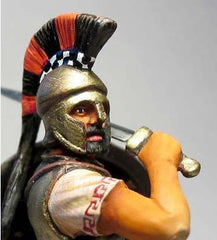Greek Hoplite with Sword
- Vendor: Design Studio
- Type: Collectibles
The Greek Hoplite comes in three popular models:
(a) The Greek Hoplite drawing the Sword
(b) The Greek Hoplite with the Spear
(c) The Greek Hoplite with Large Shield
History
Warfare in Ancient Greece centered mainly around heavy infantrymen called hoplites. The word hoplite (Greek ὁπλίτης, hoplitēs) derives from hoplon (ὅπλον, plural hopla, ὅπλα) meaning an item of armor or equipment and consequently the entire equipment of the hoplite (but not specifically the circular shield, which is sometimes incorrectly referred to as a hoplon, though it was in fact called an aspis). These soldiers probably first appeared in the late 8th century BC. They were a citizen-militia, and so were armed as spearmen, which are relatively easy to equip and maintain; they were primarily drawn from the middle class, who could afford the cost of the armaments. Almost all the famous men of ancient Greece, even the philosophers and playwrights, fought as hoplites at some point in their lives.
Since the hoplites were a militia force and did not receive permanent wages, campaigns were short and mainly confined to the summer. Armies marched directly to their target. There the defenders could hide behind city walls, in which case the attackers generally had to content themselves with ravaging the countryside as siegecraft was undeveloped, or meet them on the field. Battles were usually set piece and intended to be decisive. These battles were short, bloody, and brutal, and thus required a high degree of discipline. Both forces lined up on a level field, usually in a rough phalanx formation around eight ranks deep (though this varied). Other troops were less important; hippeis (cavalry) generally protected the flanks, when present at all, and both light infantry and missile troops were negligible.
Purchase Enquiries
For further information, you can email me directly.
Thank you.


